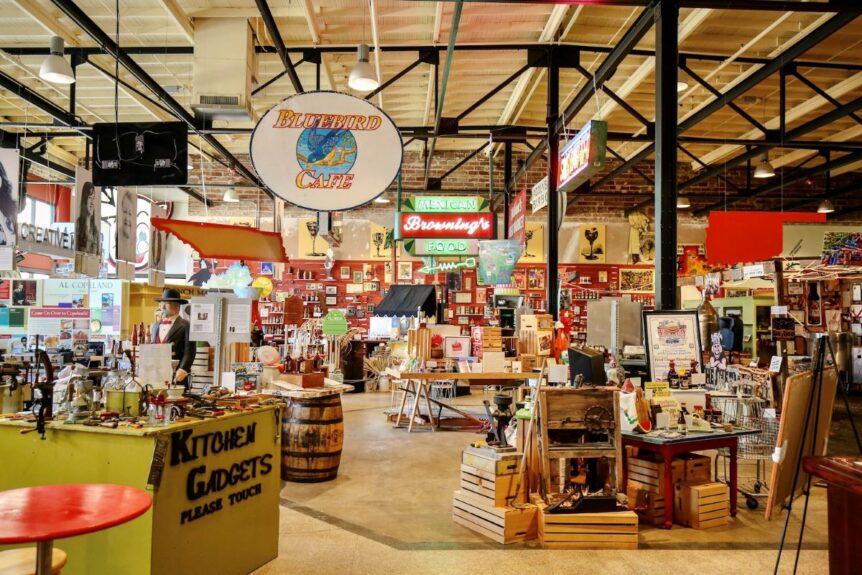
New Orleans is a hallowed pilgrimage destination for food lovers; if you truly take cuisine seriously, pay a visit to the Southern Food and Beverage Museum (SOFAB) there for a mellow, historically informed alternative to taking an afternoon nap or loafing in a barroom between meals.
Located in a former food market a few blocks off the St. Charles Avenue streetcar line, the museum exudes a cluttered charm—think rural historical society meets grandpa’s attic—but it’s animated by a smart, contemporary vision of food’s place in the broader culture. The institution’s reach is expansive, ranging geographically across fourteen southern states—from Texas to Maryland—and across history, with exhibits that detail the evolution of the cocktail, the role of enslaved Africans in spreading bean-centered dishes across the Western Hemisphere, and even the rise of fast-food entrepreneur Al Copeland, founder of the Popeyes chicken restaurant chain.




The museum began life in 2004 as a series of pop-up presentations organized by author and culinary historian Liz Williams, who hoped to build support for a cultural institution devoted to regional cuisine. “She had trouble convincing some potential funders that food was a topic worth exploring in a scholarly fashion. Even the Louisiana Endowment for the Humanities was slow to sign on,” says the museum’s current president, Brent Rosen. Today, that attitude has changed. SOFAB regularly collaborates with well-established institutions like the Historic New Orleans Collection and the Louisiana State Museum, and in 2022 opened an archive at Nunez Community College, in neighboring St. Bernard Parish, to house its collection of forty thousand culinary books and thousands of menus and pamphlets.
“We take a broad view of subjects that are fun and universal: home cooking, restaurant dining, debates about recipes, and learning to like the same drinks your great-grandparents enjoyed during Prohibition,” Rosen says. “For a lot of visitors we’re a nostalgia machine—a place to learn about the origin of the fried pickle, or to see signs for restaurants and stores that once dotted the landscape. And, with two working kitchens, we offer cooking demonstrations and classes to daytime visitors and for private events. We’re a place to meet other food lovers and to trade stories.”



Most objects in the collection have come as gifts, Rosen says, pointing to a comprehensive display of cocktail items—from nineteenth-century bottles and bar tools to tiki bar doodads from the mid-twentieth century. Much of it had been assembled in New York, by service industry pros who helped spark a revival of a taste for cocktails in the 1980s. The collection holds many surprises, including one of the Kentucky bourbon barrels that were regularly repurposed by the makers of Tabasco; a set of carafes for serving barrel bourbon in antebellum taverns; shelves ranked with many of the first branded whiskey bottles; and a useful book titled Famous New Orleans Drinks—And How to Mix ‘Em.
Another collector, Raymond Bordelon, helped flesh out SOFAB’s cocktail display by donating his trove of absinthe-related objects. La Galerie de l’Absinthe is a museum-within-the-museum, displaying specialty glasses, bar-top fountains, bottles, and a remarkable array of spoons used for the ritual preparation of a drink that nineteenth-century artists and demimonde figures once celebrated as “the green fairy.”
When SOFAB moved into its current facility in 2014, it was able to accept larger artifacts. Rosen recalled a day when he got a hurried phone call from one of the proprietors of Commander’s Palace, a fabled restaurant in the nearby Garden District: “They were bringing a crane and crew to the restaurant, to replace the outdoor electric sign with a new LED reproduction. We were offered the old sign if we could come over the next day. If not, it would go to a restaurant regular. We drove over with a pickup truck and grabbed it.”


SOFAB doesn’t just save objects from the past, however. The museum also puts them to work. Visitors can buy a drink while standing at the biggest object in the collection: a Brunswick bar—one of the several mammoth, mirrored, architecturally extravagant bar models built in the nineteenth century by an Iowa firm that also specialized in pool tables. Crafted from mahogany with decorative ivory pillars and transported from the Midwest to New Orleans in 175 pieces, the bar was a centerpiece at Bruning’s, a restaurant that opened in 1859 on the shores of Lake Pontchartrain. When the restaurant’s original building was wrecked by a 1998 hurricane, the bar went into temporary storage. Eventually, it ended up at SOFAB after Hurricane Katrina permanently shuttered the business.
“There’s a lot of history in this bar—and it’s fun to discuss it over a drink,” Rosen says. “That’s why our museum bartenders set up in the morning, when we open, and stick around for patrons until closing time. Isn’t that what you expect from a culinary museum in New Orleans?”

New Orleans journalist CHRIS WADDINGTON is a regular contributor to The Magazine ANTIQUES and other national publications. His many awards include two National Endowment for the Arts fellowships for critical writing.

